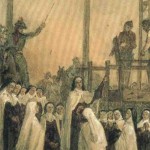From Hilary Cesare, soprano in the St. Cecilia Schola
One of the most attractive qualities of chant is its universality. Anyone who has attended Mass while traveling, especially abroad, may have experienced this first-hand. This universality of chant is not only a phenomenon across the globe in the present day. Catholics of very different times, backgrounds, and locations have been sending the same chants heavenward throughout the history of the Church. This post is intended to be the first of a series of articles that gather vivid historical accounts of Catholics singing specific chants at different times in history.
The hymn is commonly attributed to Rabanus Maurus, a Frankish Benedictine monk who lived from c. 780 to February 4, 856. He is a blessed and his feast falls on the date of his death.
Liturgically the chant is used at Vespers and Terce of Pentecost and throughout the octave. It is also sung at the election of popes, the consecration of bishops, the ordination or priests, the dedication of churches, the celebration of synods or councils, the coronation of kings, etc. [1] Any recitation merits a partial indulgence, while a plenary indulgence is granted when reciting it on January 1 or Pentecost.
Historical Accounts:
1049 – The first mention of its official use was at the Council of Rheims. “As the Pope entered the aula, the clergy, with deep devotion, sang the hymn Veni Creator Spiritus.” [2]
1202 – Several historians describe the departure of the fleet of the Fourth Crusade from Venice on the feast of St. Remigius, 1202. Robert of Clari’s account is the most vivid. “”The Doge,” he says, “had with him fifty galleys, all at his own charges. The galley in which he himself sailed was all vermilion, and there was a pavilion of red satin stretched above his head. And there were before him four trumpets of silver that trumpeted, and cymbals that made joy and merriment. And all the men of note, as well clerks as lay, and whether of small condition or great, made such joy at our departure, that never before had such joy been made or so fine a fleet been seen. And then the pilgrims caused all the priests and clerks there present to get up into the castles of the ships, and sing the Veni Creator Spiritus, and all, both the great and the small folk, wept for great joy and happiness….It seemed as if the whole sea swarmed with ants, and the ships burned on the water, and the water itself were aflame with the great joy that they had.” [3]
c. 1325 – The chant was already being sung as far east as modern-day Beijing by the fourteenth century. Odoric of Pordenone, a Franciscan missionary, describes how he, a bishop, and two brothers were outside the walls of the city waiting to greet the Khan. “When we drew near to him I placed a cross on a pole so that it could be publicly seen…And we began to sing with a loud voice, saying Veni Creator Spiritus, etc. And while we were thus singing he heard our voices and had us called to him…And when we had come to him with the cross lifted up he immediately took off his helmet…and did reverence to the cross.” [4]
1417 – The Veni Creator Spiritus has been associated with conclaves for quite some time. In 1415, Antipope John XXIII was deposed, and there was confusion about the conflicting claims to the papacy of Pope Gregory XII and Antipope Benedict XIII. The resolution involves the chant: “On November 8, 1417, fifty-three electors entered the conclave. On November 11, Cardinal Oddo Colonna…needed one vote for a two third’s majority. At that moment, a procession of intercession was passing by in the street and a large body of boys was singing the Veni Creator Spiritus. The chant sounded like an angelic choir. Thereupon two more cardinals with tears in their eyes, gave their votes to Colonna.” When the people heard the news, “everybody rushed to the Merchant’s Hall, close to eighty thousand persons, both men and women.’ Their joy was justified – the Church had once more an undoubtedly legitimate pope.” [5]
1429 – The army of the “maid of France” was said to have sung the Veni Creator Spiritus before every battle. Joan of Arc arrived at the siege of Orleans on April 29, 1429. “She rode at the head of the troops on a beautiful white horse, her banner carried before her, and a choir of priests around chanting the Veni Creator.” The siege ended in victory on May 7. “The free citizens of Orleans greeted Joan with an unprecedented outpouring of love and the singing of Veni Creator Spiritus.” [6] [7]
1553-1554 – The chant apparently played a role in Mary I’s decision to marry. “Mary told them that she spent her days and nights in tear and prayers, imploring God to direct her; and as she was speaking her emotions overcame her; she flung herself on her knees with Renard and Lady Clarence at the side, and the three together before the altar sang the ‘Veni Creator.’ The invocation was heard in the breasts from which it was uttered. As the chant died into silence, Mary rose from the ground as if inspired, and announced the divine message. The Prince of Spain was the chosen of Heaven for the virgin queen.” [8]
1769-1784 – Blessed Junipero Serra was a Spanish Franciscan known for founding nine missions in California, the first in 1769. The missions were founded in a similar way. “A rude altar was constructed, and several of the bells brought from Lower California were hung in a framework of branches erected near by. Then all the Europeans assembled, the Indians surveying the performance a few hundred yards away. Chimes were rung upon the bells, and congregation kneeled. Dressed in complete vestments, Father Serra asked a blessing and consecrated the place, while the hymn Veni Creator Spiritus was chanted. The cross was elevated and adored, holy water was sprinkled about, and mass was celebrated at an altar above which hung a banner painted to represent he Virgin Mary.” [9]
1794 – The Martyrs of Compeigne were sixteen Carmelite nuns sentenced to death after refusing to obey the Civil Constitution of the Clergy during the French Revolution. They were sent to the guillotine on July 17, 1794. “At the foot of the scaffold, the community jointly renewed their voews and began to chant the Veni Creator Spiritus…They continued singing as, one by one, they mounted the scaffold to meet their death.” [10]
1901 – On New Year’s Day, 1901, Pope Leo XIII began the year by chanting the Veni Creator Spiritus and dedicating the century to the Holy Spirit.
1911 – Yohana Kitagana was a native African and lay catechist in what is now Uganda. He evangelized areas that had not yet been visited by priests. On one occasion, “a sorcerer begged him to come at once and burn all his charms in front of his brothers. Yohana replied, “Gently, my friend. Do not harm your protecting gods, for fear could take hold of you.” They waited a week and then Yohana burnt the objects to the chanting of the ‘Veni Creator.’” [11]
2013 – The Ordo Rituum Conclavis specifies that the “Cardinal electors in choir dress will go in solemn procession, with the singing of the Veni Creator invoking the assistance of the Holy Spirit, to the Sistine Chapel.” Listen to and watch the chant at this year’s conclave here.







